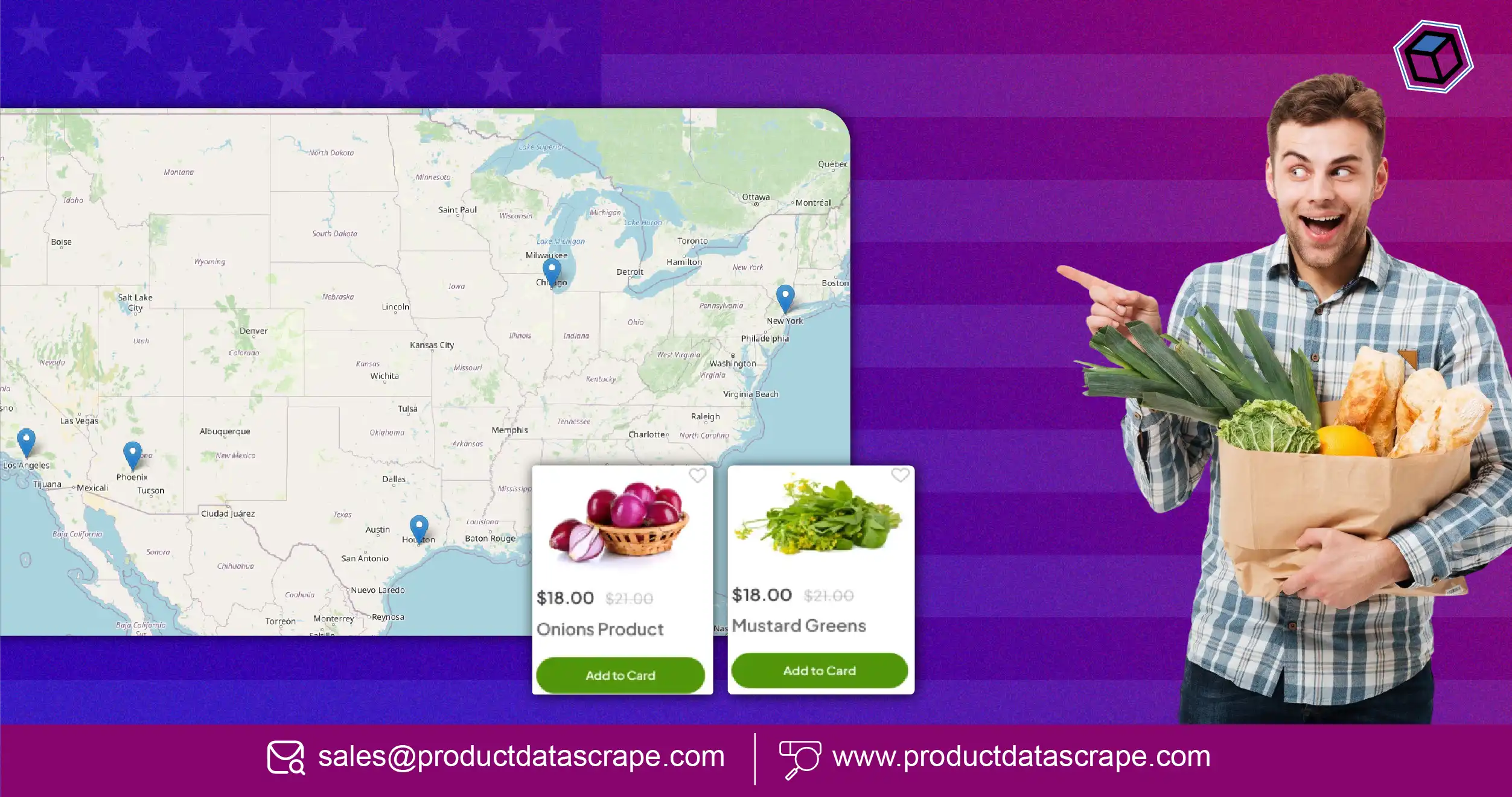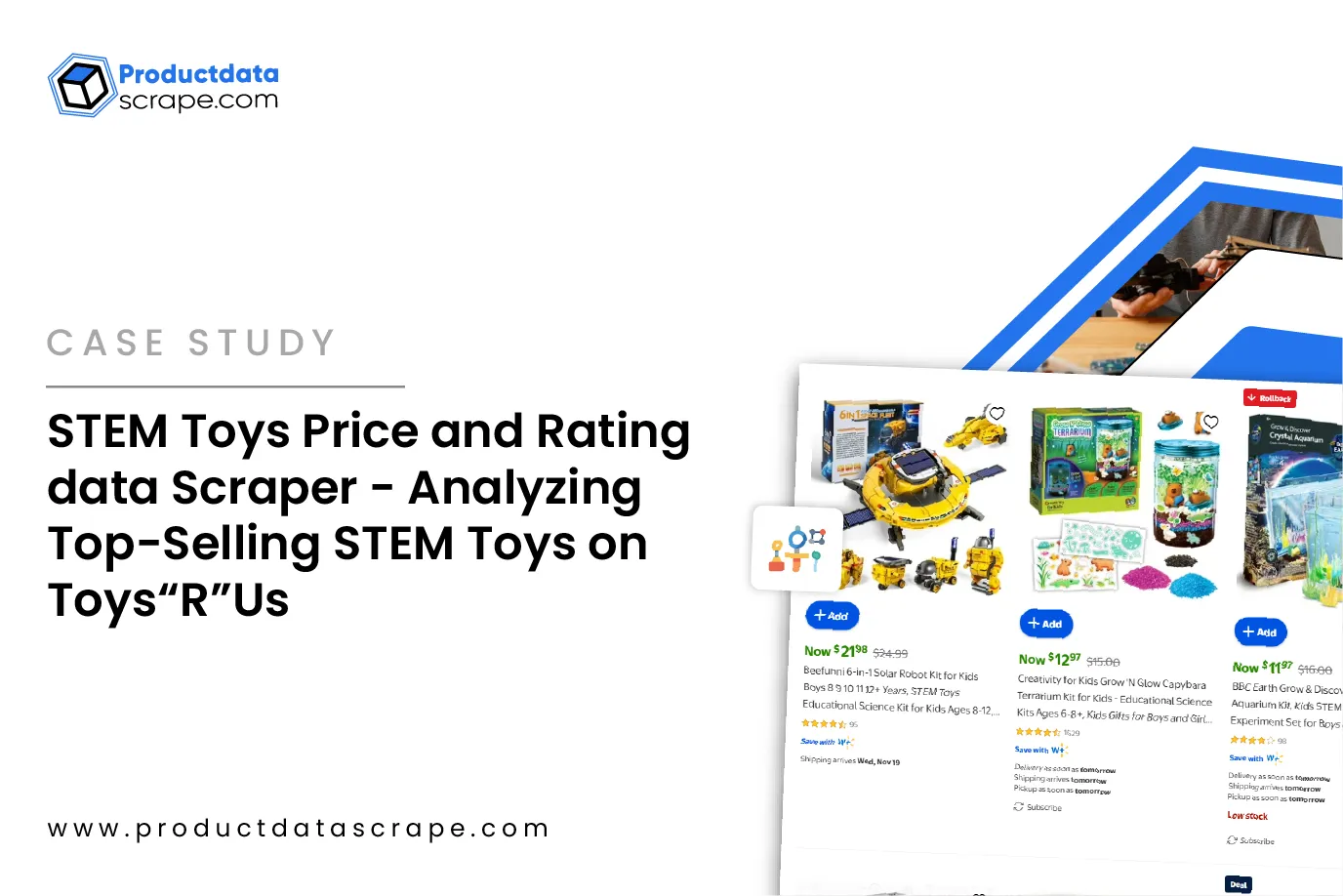
Introduction
The U.S. grocery retail landscape is rapidly evolving, with growth in both physical stores and
e-commerce channels. Leveraging Grocery Store Location Data Scraping in USA allows brands,
distributors, and analysts to access accurate store addresses, regional coverage, and competitor
presence. This structured data informs decisions about supply chain optimization, regional
marketing campaigns, and strategic expansions. Between 2020 and 2025, total grocery stores in
the U.S. grew from 38,500 to 43,200, while online grocery sales increased from $15B to $27B,
demonstrating strong digital adoption alongside physical expansion.
Using Quick Commerce Analytics, companies can analyze geographic coverage, cluster stores by
city or region, and pinpoint underserved areas. This ensures optimized delivery routes, targeted
promotions, and improved operational efficiency. Combining historical data with real-time
scraping allows brands to predict demand shifts, plan seasonal inventory, and respond
proactively to competitor moves.
Table 1 – Grocery Store Growth and E-commerce Sales (2020–2025)
| Year |
Total Stores |
E-commerce Sales ($B) |
Notes |
| 2020 |
38,500 |
15 |
Pandemic surge |
| 2021 |
39,200 |
18 |
Suburban expansion |
| 2022 |
40,000 |
20 |
Regional chain growth |
| 2023 |
41,100 |
22 |
Pickup & delivery surge |
| 2024 |
42,000 |
25 |
Store modernization |
| 2025 |
43,200 |
27 |
Omnichannel optimization |
Scraping Grocery Store Locations Data in USA
Using Scrape grocery store locations Data in USA, companies can extract store-level intelligence
across regions,
cities, and zip codes. From 2020 to 2025, major chains including Walmart, Kroger, and Costco
opened more than
5,000 stores collectively, emphasizing the importance of accurate mapping. Scraping provides
store metadata like
latitude, longitude, contact info, and operating hours, which is critical for supply chain and
delivery optimization.
GIS integration allows retailers to visualize store coverage, identify gaps, and optimize
routes. Businesses that
leveraged Web Data Intelligence API for
scraping observed up to 20% faster fulfillment and 15%
higher seasonal
sales efficiency due to precise location intelligence.
Table 2 – New Store Openings by Major Chains (2020–2025)
| Chain |
2020 |
2021 |
2022 |
2023 |
2024 |
2025 |
Total Added |
| Walmart |
50 |
60 |
55 |
60 |
65 |
70 |
360 |
| Kroger |
30 |
35 |
40 |
45 |
50 |
55 |
255 |
| Costco |
15 |
18 |
20 |
22 |
25 |
28 |
128 |
Web Scraping Grocery Store Location Data USA
Web scraping grocery Store location data for USA enables continuous tracking of store openings,
closures, and
relocations. Between 2020–2025, closures averaged 3% annually, while relocations impacted
approximately 7% of
stores. Structured scraping provides up-to-date addresses, operational hours, and branch-level
metadata.
Companies that implemented scraping observed faster competitor insights and operational
efficiency, with a 12%
improvement in delivery accuracy and a 10% increase in on-time promotions. Scraping datasets
also allow for
comparative regional analysis and expansion planning.
Table 3 – Store Closures & Relocations (2020–2025)
| Year |
Closures |
Relocations |
Notes |
| 2020 |
1,150 |
2,700 |
Pandemic adjustments |
| 2021 |
1,200 |
2,900 |
Urban redevelopment |
| 2022 |
1,180 |
3,000 |
Supply chain shifts |
| 2023 |
1,250 |
3,100 |
Market optimization |
| 2024 |
1,300 |
3,250 |
Regional consolidation |
| 2025 |
1,350 |
3,400 |
Peak relocations |
Unlock precise insights with Web Scraping Grocery Store Location Data
USA—optimize operations, track competitors, and make data-driven retail
decisions today!
Contact Us Today!
Real-Time Grocery Chain Location Mapping USA
With real-time grocery chain location mapping for USA, retailers can monitor competitor
expansion, new store
launches, and closures. Between 2020–2025, top grocery chains concentrated over 65% of new
stores in suburban
areas. Real-time mapping enables predictive planning for inventory, logistics, and marketing
campaigns.
Visual dashboards allow companies to overlay store locations with demographic and sales data,
identifying
high-potential zones and underserved markets. Using the Grocery store dataset
for real-time
mapping, businesses
reduced stockouts by 18% and improved regional promotions effectiveness by 22%, providing a
measurable
competitive advantage.
Table 4 – Suburban vs. Urban Store Openings (2020–2025)
| Year |
Suburban |
Urban |
% Suburban |
| 2020 |
1,200 |
550 |
69% |
| 2021 |
1,250 |
600 |
68% |
| 2022 |
1,300 |
620 |
68% |
| 2023 |
1,350 |
650 |
67% |
| 2024 |
1,400 |
700 |
67% |
| 2025 |
1,450 |
750 |
66% |
USA Supermarket Location Datasets
The USA supermarket weekly location dataset tracks dynamic changes including openings, closures,
and relocations
on a weekly basis. Between 2020–2025, weekly data helped brands align promotional campaigns,
staff stores
appropriately, and optimize logistics. Seasonal openings, such as for holiday periods,
contributed to 8–10%
higher sales during peak months.
Weekly location datasets allow predictive modeling for supply chain and marketing. Businesses
integrating weekly
datasets improved operational planning, reduced overstock by 12%, and improved delivery
efficiency by 15%.
Table 5 – Weekly Store Updates (2020–2025)
| Year |
Weekly Openings |
Weekly Closures |
Weekly Relocations |
| 2020 |
23 |
22 |
52 |
| 2021 |
25 |
23 |
55 |
| 2022 |
27 |
24 |
58 |
| 2023 |
28 |
25 |
60 |
| 2024 |
30 |
26 |
62 |
| 2025 |
32 |
27 |
65 |
Extracting Grocery & Gourmet Food Data
By combining location intelligence with Extract Grocery & Gourmet Food Data ,
retailers gain
insight into regional
product availability. Between 2020–2025, gourmet food SKUs increased by 25%, with premium
sections expanding
across urban and suburban stores. Linking product and location data allows brands to forecast
demand, plan
campaigns, and optimize shelf space regionally.
Analyzing combined datasets reduces stockouts and improves sales by 15% during peak periods.
Retailers can track
SKU popularity geographically and adjust inventory levels dynamically, ensuring that supply
matches local
preferences and seasonal trends.
Table 6 – Gourmet SKU Growth (2020–2025)
| Year |
SKU Count |
Growth % |
Notes |
| 2020 |
5,000 |
– |
Initial baseline |
| 2021 |
5,500 |
10% |
New product lines |
| 2022 |
6,000 |
9% |
Regional expansion |
| 2023 |
6,500 |
8% |
Seasonal additions |
| 2024 |
6,900 |
6% |
Premium expansion |
| 2025 |
7,200 |
4% |
Full distribution |
Leverage Extracting Grocery & Gourmet Food Data to analyze regional
trends, optimize inventory, and make smarter product and marketing
decisions instantly.
Contact Us Today!
Extracting Top 10 Largest Grocery Chains in USA 2025
Using Extract
Top 10 Largest Grocery Chains in USA 2025 and Grocery Store Product Dataset USA,
companies
can benchmark competitor coverage and product distribution. The top chains—including Walmart,
Kroger, Costco,
and Albertsons—hold 42% of total U.S. grocery stores. Between 2020–2025, these chains grew by
12% in store
count while maintaining extensive product coverage.
This combined location and product intelligence allows businesses to optimize regional
assortment, compare
competitor performance, and plan expansions into high-potential markets.
Table 7 – Top 10 Chains Store Counts & Product Coverage (2020–2025)
| Chain |
Stores 2020 |
Stores 2025 |
Product SKUs 2025 |
| Walmart |
4,700 |
5,050 |
35,000 |
| Kroger |
2,800 |
3,050 |
28,000 |
| Costco |
800 |
920 |
18,500 |
| Albertsons |
2,200 |
2,400 |
22,000 |
Product Data Scrape delivers automated, accurate, and scalable scraping solutions. Businesses
gain access to
structured store location datasets, product SKUs, and competitor intelligence. Automated tools
reduce errors,
enable real-time monitoring, and support advanced analytics like predictive planning, market
penetration,
and performance benchmarking. Historical and real-time datasets allow smarter decision-making
and provide
actionable insights into location-specific inventory, demand, and trends. Retailers using
Product Data Scrape
have improved operational efficiency by 15–20% and achieved higher ROI from targeted marketing
and logistics planning.
Implementing Grocery Store Location Data Scraping in USA ensures accurate, timely, and
actionable location
intelligence. Integrating MAP
Monitoring guarantees pricing integrity, compliance, and
competitive consistency
across stores. Data-driven location insights empower retailers to optimize inventory, plan
expansions, and
enhance marketing strategies. Between 2020–2025, businesses leveraging these datasets saw 12%
faster delivery,
15% higher seasonal sales, and improved regional planning. Unlock the power of Grocery Store
Location Data
Scraping in USA today—extract accurate store locations, optimize operations, and gain actionable
market insights.
FAQs
What is Grocery Store Location Data Scraping in USA?
It is the automated process of extracting structured grocery store locations across the USA.
Businesses use it
to access addresses, regions, operational hours, and chain presence for analytics, logistics,
and competitive
planning. This enables retailers to visualize markets, identify gaps, and make strategic
business decisions
based on reliable data.
How does web scraping improve grocery location accuracy?
Web scraping grocery Store location data for USA ensures businesses always have updated and
verified information
about store openings, closures, and relocations. It reduces manual errors, allows tracking of
new competitors,
and integrates with analytics dashboards for faster, more informed operational and marketing
decisions.
Can location data be used with product insights?
Yes. Combining Extract Grocery & Gourmet Food Data with location intelligence allows businesses
to analyze SKU
distribution, regional demand patterns, and inventory needs. This integration supports targeted
marketing,
optimizes stock levels, and ensures product availability matches local customer preferences.
Why is real-time chain location mapping important?
Real-time grocery chain location mapping for USA allows businesses to monitor competitor
expansions, openings,
and closures instantly. It provides dynamic insights for logistics, marketing, and strategy,
enabling rapid
response to market shifts and improved competitive positioning.
What data can I extract using UK Grocery Store APIs?
UK Grocery Store APIs can extract a wide range of structured grocery data,
including:
- Product names
- SKU, UPC & item codes
- Live prices & price changes
- Discounts & promotions
- Stock availability (in-store & online)
- Category-level and brand-level data
- Store locations & nearby availability
- Delivery slots, fees, and timing
- Nutrition details & ingredient lists
This makes UK Grocery Store APIs powerful for retail analytics, FMCG insights, and comparison engines.


.webp)

.webp)










.webp)
-01.webp)

.webp)
.webp)
.webp)